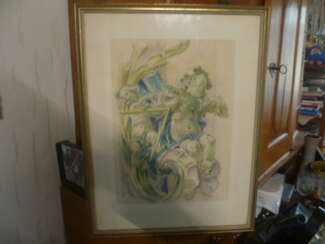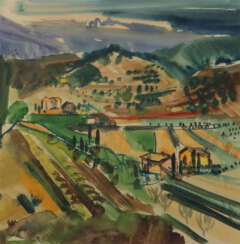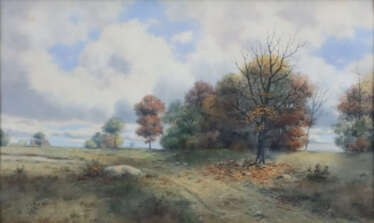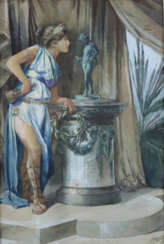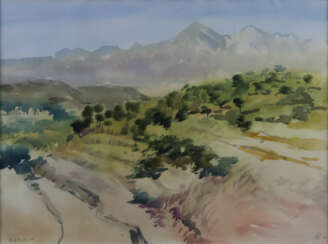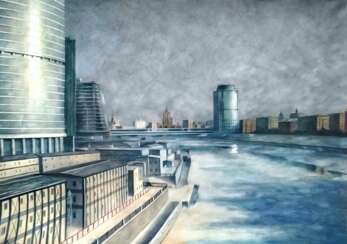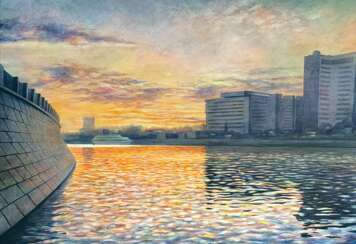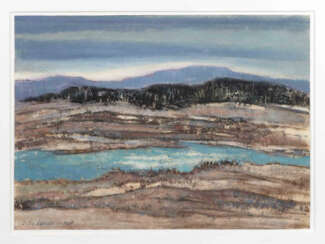344 Items by auctions and galleries:
aquarell auf papier
Paintings by Denis Veles
Denis Veles (b. 1984)  Shop Veles Denis
Shop Veles Denis

Denis Veles
30.12.1984
Russia
Велес Денис Сварожич – художник-график, родился и проживает в Москве. Из дворянского польского рода Лис-Олтаржевских. Внук заслуженного художника РСФСР.
В 2008 году окончил МГХПУ им. Строганова Кафедры «Искусства графики». Имеет медаль «За заслуги в культуре и искусстве». Художник с институциональным признанием.
Одну из его картин «Крымский мост», станковая графика, можно увидеть в информационных изданиях об академии на английском языке «МГХПА 2021 проспект» и к 190 лет МГХПА им. С.Г. Строганова.
С 2004 года Денис Велес участвует в благотворительных выставках и фестивалях в Москве. Акварель Дениса Велеса была признана национальным наследием как институциональное достояние королевства Испании.
Paintings by Denis Veles Russian artist graphics.Graphics. Watercolour. Moscow Union of Artists. Masterpiece. Gallery. Collection.
Lukisan oleh Denis Veles seniman Rusia grafis.Grafis. Cat air. Persatuan Seniman Moskow. Mahakarya. Galeri. Koleksi.
Pinturas de Denis Veles artista ruso graphics.Graphics. Acuarela. Unión de Artistas de Moscú. Obra maestra. Galería. Colección.
Dipinti di Denis Veles artista russo grafica.Grafica. Acquerello. Unione degli artisti di Mosca. Capolavoro. Galleria. Collezione.
Denis Veles 的画作 俄罗斯艺术家图画。水彩画。莫斯科艺术家联盟。杰作。画廊。收藏。
Gemälde von Denis Veles Russischer Künstler Graphik.Graphik. Aquarell. Moskauer Union der Künstler. Meisterwerk. Galerie. Sammlung.
Pinturas de Denis Veles Gráficos de artistas russos.Gráficos. Aguarela. União dos Artistas de Moscovo. Obra-prima. Galeria. Coleção.
Peintures de Denis Veles Artiste graphique russe.Graphiques. Aquarelle. Union des artistes de Moscou. Chef-d'œuvre. Galerie. Collection.
Denis Velesによる絵画 ロシア人アーティスト graphics.グラフィック. 水彩画。モスクワ芸術家連合。傑作. ギャラリー. コレクション。
لوحات للرسام دينيس فيليس، فنان جرافيك روسي. ألوان مائية. اتحاد موسكو للفنانين. تحفة. صالة عرض. مجموعة.

Artist shop
Veles Denis
Russia
Number of products: 37
Большие картины в интерьер
Denis Veles (b. 1984)  Shop Veles Denis
Shop Veles Denis

Denis Veles
30.12.1984
Russia
Велес Денис Сварожич – художник-график, родился и проживает в Москве. Из дворянского польского рода Лис-Олтаржевских. Внук заслуженного художника РСФСР.
В 2008 году окончил МГХПУ им. Строганова Кафедры «Искусства графики». Имеет медаль «За заслуги в культуре и искусстве». Художник с институциональным признанием.
Одну из его картин «Крымский мост», станковая графика, можно увидеть в информационных изданиях об академии на английском языке «МГХПА 2021 проспект» и к 190 лет МГХПА им. С.Г. Строганова.
С 2004 года Денис Велес участвует в благотворительных выставках и фестивалях в Москве. Акварель Дениса Велеса была признана национальным наследием как институциональное достояние королевства Испании.
Paintings by Denis Veles Russian artist graphics.Graphics. Watercolour. Moscow Union of Artists. Masterpiece. Gallery. Collection.
Lukisan oleh Denis Veles seniman Rusia grafis.Grafis. Cat air. Persatuan Seniman Moskow. Mahakarya. Galeri. Koleksi.
Pinturas de Denis Veles artista ruso graphics.Graphics. Acuarela. Unión de Artistas de Moscú. Obra maestra. Galería. Colección.
Dipinti di Denis Veles artista russo grafica.Grafica. Acquerello. Unione degli artisti di Mosca. Capolavoro. Galleria. Collezione.
Denis Veles 的画作 俄罗斯艺术家图画。水彩画。莫斯科艺术家联盟。杰作。画廊。收藏。
Gemälde von Denis Veles Russischer Künstler Graphik.Graphik. Aquarell. Moskauer Union der Künstler. Meisterwerk. Galerie. Sammlung.
Pinturas de Denis Veles Gráficos de artistas russos.Gráficos. Aguarela. União dos Artistas de Moscovo. Obra-prima. Galeria. Coleção.
Peintures de Denis Veles Artiste graphique russe.Graphiques. Aquarelle. Union des artistes de Moscou. Chef-d'œuvre. Galerie. Collection.
Denis Velesによる絵画 ロシア人アーティスト graphics.グラフィック. 水彩画。モスクワ芸術家連合。傑作. ギャラリー. コレクション。
لوحات للرسام دينيس فيليس، فنان جرافيك روسي. ألوان مائية. اتحاد موسكو للفنانين. تحفة. صالة عرض. مجموعة.

Artist shop
Veles Denis
Russia
Number of products: 37
Investment/Artist Denis Veles.
Denis Veles (b. 1984)  Shop Veles Denis
Shop Veles Denis

Denis Veles
30.12.1984
Russia
Велес Денис Сварожич – художник-график, родился и проживает в Москве. Из дворянского польского рода Лис-Олтаржевских. Внук заслуженного художника РСФСР.
В 2008 году окончил МГХПУ им. Строганова Кафедры «Искусства графики». Имеет медаль «За заслуги в культуре и искусстве». Художник с институциональным признанием.
Одну из его картин «Крымский мост», станковая графика, можно увидеть в информационных изданиях об академии на английском языке «МГХПА 2021 проспект» и к 190 лет МГХПА им. С.Г. Строганова.
С 2004 года Денис Велес участвует в благотворительных выставках и фестивалях в Москве. Акварель Дениса Велеса была признана национальным наследием как институциональное достояние королевства Испании.
Paintings by Denis Veles Russian artist graphics.Graphics. Watercolour. Moscow Union of Artists. Masterpiece. Gallery. Collection.
Lukisan oleh Denis Veles seniman Rusia grafis.Grafis. Cat air. Persatuan Seniman Moskow. Mahakarya. Galeri. Koleksi.
Pinturas de Denis Veles artista ruso graphics.Graphics. Acuarela. Unión de Artistas de Moscú. Obra maestra. Galería. Colección.
Dipinti di Denis Veles artista russo grafica.Grafica. Acquerello. Unione degli artisti di Mosca. Capolavoro. Galleria. Collezione.
Denis Veles 的画作 俄罗斯艺术家图画。水彩画。莫斯科艺术家联盟。杰作。画廊。收藏。
Gemälde von Denis Veles Russischer Künstler Graphik.Graphik. Aquarell. Moskauer Union der Künstler. Meisterwerk. Galerie. Sammlung.
Pinturas de Denis Veles Gráficos de artistas russos.Gráficos. Aguarela. União dos Artistas de Moscovo. Obra-prima. Galeria. Coleção.
Peintures de Denis Veles Artiste graphique russe.Graphiques. Aquarelle. Union des artistes de Moscou. Chef-d'œuvre. Galerie. Collection.
Denis Velesによる絵画 ロシア人アーティスト graphics.グラフィック. 水彩画。モスクワ芸術家連合。傑作. ギャラリー. コレクション。
لوحات للرسام دينيس فيليس، فنان جرافيك روسي. ألوان مائية. اتحاد موسكو للفنانين. تحفة. صالة عرض. مجموعة.

Artist shop
Veles Denis
Russia
Number of products: 37
Paintings by Denis Veles
Denis Veles (b. 1984)  Shop Veles Denis
Shop Veles Denis

Denis Veles
30.12.1984
Russia
Велес Денис Сварожич – художник-график, родился и проживает в Москве. Из дворянского польского рода Лис-Олтаржевских. Внук заслуженного художника РСФСР.
В 2008 году окончил МГХПУ им. Строганова Кафедры «Искусства графики». Имеет медаль «За заслуги в культуре и искусстве». Художник с институциональным признанием.
Одну из его картин «Крымский мост», станковая графика, можно увидеть в информационных изданиях об академии на английском языке «МГХПА 2021 проспект» и к 190 лет МГХПА им. С.Г. Строганова.
С 2004 года Денис Велес участвует в благотворительных выставках и фестивалях в Москве. Акварель Дениса Велеса была признана национальным наследием как институциональное достояние королевства Испании.
Paintings by Denis Veles Russian artist graphics.Graphics. Watercolour. Moscow Union of Artists. Masterpiece. Gallery. Collection.
Lukisan oleh Denis Veles seniman Rusia grafis.Grafis. Cat air. Persatuan Seniman Moskow. Mahakarya. Galeri. Koleksi.
Pinturas de Denis Veles artista ruso graphics.Graphics. Acuarela. Unión de Artistas de Moscú. Obra maestra. Galería. Colección.
Dipinti di Denis Veles artista russo grafica.Grafica. Acquerello. Unione degli artisti di Mosca. Capolavoro. Galleria. Collezione.
Denis Veles 的画作 俄罗斯艺术家图画。水彩画。莫斯科艺术家联盟。杰作。画廊。收藏。
Gemälde von Denis Veles Russischer Künstler Graphik.Graphik. Aquarell. Moskauer Union der Künstler. Meisterwerk. Galerie. Sammlung.
Pinturas de Denis Veles Gráficos de artistas russos.Gráficos. Aguarela. União dos Artistas de Moscovo. Obra-prima. Galeria. Coleção.
Peintures de Denis Veles Artiste graphique russe.Graphiques. Aquarelle. Union des artistes de Moscou. Chef-d'œuvre. Galerie. Collection.
Denis Velesによる絵画 ロシア人アーティスト graphics.グラフィック. 水彩画。モスクワ芸術家連合。傑作. ギャラリー. コレクション。
لوحات للرسام دينيس فيليس، فنان جرافيك روسي. ألوان مائية. اتحاد موسكو للفنانين. تحفة. صالة عرض. مجموعة.

Artist shop
Veles Denis
Russia
Number of products: 37
Investment/Artist Denis Veles.
Denis Veles (b. 1984)  Shop Veles Denis
Shop Veles Denis

Denis Veles
30.12.1984
Russia
Велес Денис Сварожич – художник-график, родился и проживает в Москве. Из дворянского польского рода Лис-Олтаржевских. Внук заслуженного художника РСФСР.
В 2008 году окончил МГХПУ им. Строганова Кафедры «Искусства графики». Имеет медаль «За заслуги в культуре и искусстве». Художник с институциональным признанием.
Одну из его картин «Крымский мост», станковая графика, можно увидеть в информационных изданиях об академии на английском языке «МГХПА 2021 проспект» и к 190 лет МГХПА им. С.Г. Строганова.
С 2004 года Денис Велес участвует в благотворительных выставках и фестивалях в Москве. Акварель Дениса Велеса была признана национальным наследием как институциональное достояние королевства Испании.
Paintings by Denis Veles Russian artist graphics.Graphics. Watercolour. Moscow Union of Artists. Masterpiece. Gallery. Collection.
Lukisan oleh Denis Veles seniman Rusia grafis.Grafis. Cat air. Persatuan Seniman Moskow. Mahakarya. Galeri. Koleksi.
Pinturas de Denis Veles artista ruso graphics.Graphics. Acuarela. Unión de Artistas de Moscú. Obra maestra. Galería. Colección.
Dipinti di Denis Veles artista russo grafica.Grafica. Acquerello. Unione degli artisti di Mosca. Capolavoro. Galleria. Collezione.
Denis Veles 的画作 俄罗斯艺术家图画。水彩画。莫斯科艺术家联盟。杰作。画廊。收藏。
Gemälde von Denis Veles Russischer Künstler Graphik.Graphik. Aquarell. Moskauer Union der Künstler. Meisterwerk. Galerie. Sammlung.
Pinturas de Denis Veles Gráficos de artistas russos.Gráficos. Aguarela. União dos Artistas de Moscovo. Obra-prima. Galeria. Coleção.
Peintures de Denis Veles Artiste graphique russe.Graphiques. Aquarelle. Union des artistes de Moscou. Chef-d'œuvre. Galerie. Collection.
Denis Velesによる絵画 ロシア人アーティスト graphics.グラフィック. 水彩画。モスクワ芸術家連合。傑作. ギャラリー. コレクション。
لوحات للرسام دينيس فيليس، فنان جرافيك روسي. ألوان مائية. اتحاد موسكو للفنانين. تحفة. صالة عرض. مجموعة.

Artist shop
Veles Denis
Russia
Number of products: 37
Paintings by Denis Veles
Denis Veles (b. 1984)  Shop Veles Denis
Shop Veles Denis

Denis Veles
30.12.1984
Russia
Велес Денис Сварожич – художник-график, родился и проживает в Москве. Из дворянского польского рода Лис-Олтаржевских. Внук заслуженного художника РСФСР.
В 2008 году окончил МГХПУ им. Строганова Кафедры «Искусства графики». Имеет медаль «За заслуги в культуре и искусстве». Художник с институциональным признанием.
Одну из его картин «Крымский мост», станковая графика, можно увидеть в информационных изданиях об академии на английском языке «МГХПА 2021 проспект» и к 190 лет МГХПА им. С.Г. Строганова.
С 2004 года Денис Велес участвует в благотворительных выставках и фестивалях в Москве. Акварель Дениса Велеса была признана национальным наследием как институциональное достояние королевства Испании.
Paintings by Denis Veles Russian artist graphics.Graphics. Watercolour. Moscow Union of Artists. Masterpiece. Gallery. Collection.
Lukisan oleh Denis Veles seniman Rusia grafis.Grafis. Cat air. Persatuan Seniman Moskow. Mahakarya. Galeri. Koleksi.
Pinturas de Denis Veles artista ruso graphics.Graphics. Acuarela. Unión de Artistas de Moscú. Obra maestra. Galería. Colección.
Dipinti di Denis Veles artista russo grafica.Grafica. Acquerello. Unione degli artisti di Mosca. Capolavoro. Galleria. Collezione.
Denis Veles 的画作 俄罗斯艺术家图画。水彩画。莫斯科艺术家联盟。杰作。画廊。收藏。
Gemälde von Denis Veles Russischer Künstler Graphik.Graphik. Aquarell. Moskauer Union der Künstler. Meisterwerk. Galerie. Sammlung.
Pinturas de Denis Veles Gráficos de artistas russos.Gráficos. Aguarela. União dos Artistas de Moscovo. Obra-prima. Galeria. Coleção.
Peintures de Denis Veles Artiste graphique russe.Graphiques. Aquarelle. Union des artistes de Moscou. Chef-d'œuvre. Galerie. Collection.
Denis Velesによる絵画 ロシア人アーティスト graphics.グラフィック. 水彩画。モスクワ芸術家連合。傑作. ギャラリー. コレクション。
لوحات للرسام دينيس فيليس، فنان جرافيك روسي. ألوان مائية. اتحاد موسكو للفنانين. تحفة. صالة عرض. مجموعة.

Artist shop
Veles Denis
Russia
Number of products: 37
Investment/Artist Denis Veles.
Denis Veles (b. 1984)  Shop Veles Denis
Shop Veles Denis

Denis Veles
30.12.1984
Russia
Велес Денис Сварожич – художник-график, родился и проживает в Москве. Из дворянского польского рода Лис-Олтаржевских. Внук заслуженного художника РСФСР.
В 2008 году окончил МГХПУ им. Строганова Кафедры «Искусства графики». Имеет медаль «За заслуги в культуре и искусстве». Художник с институциональным признанием.
Одну из его картин «Крымский мост», станковая графика, можно увидеть в информационных изданиях об академии на английском языке «МГХПА 2021 проспект» и к 190 лет МГХПА им. С.Г. Строганова.
С 2004 года Денис Велес участвует в благотворительных выставках и фестивалях в Москве. Акварель Дениса Велеса была признана национальным наследием как институциональное достояние королевства Испании.
Paintings by Denis Veles Russian artist graphics.Graphics. Watercolour. Moscow Union of Artists. Masterpiece. Gallery. Collection.
Lukisan oleh Denis Veles seniman Rusia grafis.Grafis. Cat air. Persatuan Seniman Moskow. Mahakarya. Galeri. Koleksi.
Pinturas de Denis Veles artista ruso graphics.Graphics. Acuarela. Unión de Artistas de Moscú. Obra maestra. Galería. Colección.
Dipinti di Denis Veles artista russo grafica.Grafica. Acquerello. Unione degli artisti di Mosca. Capolavoro. Galleria. Collezione.
Denis Veles 的画作 俄罗斯艺术家图画。水彩画。莫斯科艺术家联盟。杰作。画廊。收藏。
Gemälde von Denis Veles Russischer Künstler Graphik.Graphik. Aquarell. Moskauer Union der Künstler. Meisterwerk. Galerie. Sammlung.
Pinturas de Denis Veles Gráficos de artistas russos.Gráficos. Aguarela. União dos Artistas de Moscovo. Obra-prima. Galeria. Coleção.
Peintures de Denis Veles Artiste graphique russe.Graphiques. Aquarelle. Union des artistes de Moscou. Chef-d'œuvre. Galerie. Collection.
Denis Velesによる絵画 ロシア人アーティスト graphics.グラフィック. 水彩画。モスクワ芸術家連合。傑作. ギャラリー. コレクション。
لوحات للرسام دينيس فيليس، فنان جرافيك روسي. ألوان مائية. اتحاد موسكو للفنانين. تحفة. صالة عرض. مجموعة.

Artist shop
Veles Denis
Russia
Number of products: 37
Paintings by Denis Veles
Denis Veles (b. 1984)  Shop Veles Denis
Shop Veles Denis

Denis Veles
30.12.1984
Russia
Велес Денис Сварожич – художник-график, родился и проживает в Москве. Из дворянского польского рода Лис-Олтаржевских. Внук заслуженного художника РСФСР.
В 2008 году окончил МГХПУ им. Строганова Кафедры «Искусства графики». Имеет медаль «За заслуги в культуре и искусстве». Художник с институциональным признанием.
Одну из его картин «Крымский мост», станковая графика, можно увидеть в информационных изданиях об академии на английском языке «МГХПА 2021 проспект» и к 190 лет МГХПА им. С.Г. Строганова.
С 2004 года Денис Велес участвует в благотворительных выставках и фестивалях в Москве. Акварель Дениса Велеса была признана национальным наследием как институциональное достояние королевства Испании.
Paintings by Denis Veles Russian artist graphics.Graphics. Watercolour. Moscow Union of Artists. Masterpiece. Gallery. Collection.
Lukisan oleh Denis Veles seniman Rusia grafis.Grafis. Cat air. Persatuan Seniman Moskow. Mahakarya. Galeri. Koleksi.
Pinturas de Denis Veles artista ruso graphics.Graphics. Acuarela. Unión de Artistas de Moscú. Obra maestra. Galería. Colección.
Dipinti di Denis Veles artista russo grafica.Grafica. Acquerello. Unione degli artisti di Mosca. Capolavoro. Galleria. Collezione.
Denis Veles 的画作 俄罗斯艺术家图画。水彩画。莫斯科艺术家联盟。杰作。画廊。收藏。
Gemälde von Denis Veles Russischer Künstler Graphik.Graphik. Aquarell. Moskauer Union der Künstler. Meisterwerk. Galerie. Sammlung.
Pinturas de Denis Veles Gráficos de artistas russos.Gráficos. Aguarela. União dos Artistas de Moscovo. Obra-prima. Galeria. Coleção.
Peintures de Denis Veles Artiste graphique russe.Graphiques. Aquarelle. Union des artistes de Moscou. Chef-d'œuvre. Galerie. Collection.
Denis Velesによる絵画 ロシア人アーティスト graphics.グラフィック. 水彩画。モスクワ芸術家連合。傑作. ギャラリー. コレクション。
لوحات للرسام دينيس فيليس، فنان جرافيك روسي. ألوان مائية. اتحاد موسكو للفنانين. تحفة. صالة عرض. مجموعة.

Artist shop
Veles Denis
Russia
Number of products: 37
Paintings by Denis Veles
Denis Veles (b. 1984)  Shop Veles Denis
Shop Veles Denis

Denis Veles
30.12.1984
Russia
Велес Денис Сварожич – художник-график, родился и проживает в Москве. Из дворянского польского рода Лис-Олтаржевских. Внук заслуженного художника РСФСР.
В 2008 году окончил МГХПУ им. Строганова Кафедры «Искусства графики». Имеет медаль «За заслуги в культуре и искусстве». Художник с институциональным признанием.
Одну из его картин «Крымский мост», станковая графика, можно увидеть в информационных изданиях об академии на английском языке «МГХПА 2021 проспект» и к 190 лет МГХПА им. С.Г. Строганова.
С 2004 года Денис Велес участвует в благотворительных выставках и фестивалях в Москве. Акварель Дениса Велеса была признана национальным наследием как институциональное достояние королевства Испании.
Paintings by Denis Veles Russian artist graphics.Graphics. Watercolour. Moscow Union of Artists. Masterpiece. Gallery. Collection.
Lukisan oleh Denis Veles seniman Rusia grafis.Grafis. Cat air. Persatuan Seniman Moskow. Mahakarya. Galeri. Koleksi.
Pinturas de Denis Veles artista ruso graphics.Graphics. Acuarela. Unión de Artistas de Moscú. Obra maestra. Galería. Colección.
Dipinti di Denis Veles artista russo grafica.Grafica. Acquerello. Unione degli artisti di Mosca. Capolavoro. Galleria. Collezione.
Denis Veles 的画作 俄罗斯艺术家图画。水彩画。莫斯科艺术家联盟。杰作。画廊。收藏。
Gemälde von Denis Veles Russischer Künstler Graphik.Graphik. Aquarell. Moskauer Union der Künstler. Meisterwerk. Galerie. Sammlung.
Pinturas de Denis Veles Gráficos de artistas russos.Gráficos. Aguarela. União dos Artistas de Moscovo. Obra-prima. Galeria. Coleção.
Peintures de Denis Veles Artiste graphique russe.Graphiques. Aquarelle. Union des artistes de Moscou. Chef-d'œuvre. Galerie. Collection.
Denis Velesによる絵画 ロシア人アーティスト graphics.グラフィック. 水彩画。モスクワ芸術家連合。傑作. ギャラリー. コレクション。
لوحات للرسام دينيس فيليس، فنان جرافيك روسي. ألوان مائية. اتحاد موسكو للفنانين. تحفة. صالة عرض. مجموعة.

Artist shop
Veles Denis
Russia
Number of products: 37
Investment/Artist Denis Veles.
Denis Veles (b. 1984)  Shop Veles Denis
Shop Veles Denis

Denis Veles
30.12.1984
Russia
Велес Денис Сварожич – художник-график, родился и проживает в Москве. Из дворянского польского рода Лис-Олтаржевских. Внук заслуженного художника РСФСР.
В 2008 году окончил МГХПУ им. Строганова Кафедры «Искусства графики». Имеет медаль «За заслуги в культуре и искусстве». Художник с институциональным признанием.
Одну из его картин «Крымский мост», станковая графика, можно увидеть в информационных изданиях об академии на английском языке «МГХПА 2021 проспект» и к 190 лет МГХПА им. С.Г. Строганова.
С 2004 года Денис Велес участвует в благотворительных выставках и фестивалях в Москве. Акварель Дениса Велеса была признана национальным наследием как институциональное достояние королевства Испании.
Paintings by Denis Veles Russian artist graphics.Graphics. Watercolour. Moscow Union of Artists. Masterpiece. Gallery. Collection.
Lukisan oleh Denis Veles seniman Rusia grafis.Grafis. Cat air. Persatuan Seniman Moskow. Mahakarya. Galeri. Koleksi.
Pinturas de Denis Veles artista ruso graphics.Graphics. Acuarela. Unión de Artistas de Moscú. Obra maestra. Galería. Colección.
Dipinti di Denis Veles artista russo grafica.Grafica. Acquerello. Unione degli artisti di Mosca. Capolavoro. Galleria. Collezione.
Denis Veles 的画作 俄罗斯艺术家图画。水彩画。莫斯科艺术家联盟。杰作。画廊。收藏。
Gemälde von Denis Veles Russischer Künstler Graphik.Graphik. Aquarell. Moskauer Union der Künstler. Meisterwerk. Galerie. Sammlung.
Pinturas de Denis Veles Gráficos de artistas russos.Gráficos. Aguarela. União dos Artistas de Moscovo. Obra-prima. Galeria. Coleção.
Peintures de Denis Veles Artiste graphique russe.Graphiques. Aquarelle. Union des artistes de Moscou. Chef-d'œuvre. Galerie. Collection.
Denis Velesによる絵画 ロシア人アーティスト graphics.グラフィック. 水彩画。モスクワ芸術家連合。傑作. ギャラリー. コレクション。
لوحات للرسام دينيس فيليس، فنان جرافيك روسي. ألوان مائية. اتحاد موسكو للفنانين. تحفة. صالة عرض. مجموعة.

Artist shop
Veles Denis
Russia
Number of products: 37
Paintings by Denis Veles
Denis Veles (b. 1984)  Shop Veles Denis
Shop Veles Denis

Denis Veles
30.12.1984
Russia
Велес Денис Сварожич – художник-график, родился и проживает в Москве. Из дворянского польского рода Лис-Олтаржевских. Внук заслуженного художника РСФСР.
В 2008 году окончил МГХПУ им. Строганова Кафедры «Искусства графики». Имеет медаль «За заслуги в культуре и искусстве». Художник с институциональным признанием.
Одну из его картин «Крымский мост», станковая графика, можно увидеть в информационных изданиях об академии на английском языке «МГХПА 2021 проспект» и к 190 лет МГХПА им. С.Г. Строганова.
С 2004 года Денис Велес участвует в благотворительных выставках и фестивалях в Москве. Акварель Дениса Велеса была признана национальным наследием как институциональное достояние королевства Испании.
Paintings by Denis Veles Russian artist graphics.Graphics. Watercolour. Moscow Union of Artists. Masterpiece. Gallery. Collection.
Lukisan oleh Denis Veles seniman Rusia grafis.Grafis. Cat air. Persatuan Seniman Moskow. Mahakarya. Galeri. Koleksi.
Pinturas de Denis Veles artista ruso graphics.Graphics. Acuarela. Unión de Artistas de Moscú. Obra maestra. Galería. Colección.
Dipinti di Denis Veles artista russo grafica.Grafica. Acquerello. Unione degli artisti di Mosca. Capolavoro. Galleria. Collezione.
Denis Veles 的画作 俄罗斯艺术家图画。水彩画。莫斯科艺术家联盟。杰作。画廊。收藏。
Gemälde von Denis Veles Russischer Künstler Graphik.Graphik. Aquarell. Moskauer Union der Künstler. Meisterwerk. Galerie. Sammlung.
Pinturas de Denis Veles Gráficos de artistas russos.Gráficos. Aguarela. União dos Artistas de Moscovo. Obra-prima. Galeria. Coleção.
Peintures de Denis Veles Artiste graphique russe.Graphiques. Aquarelle. Union des artistes de Moscou. Chef-d'œuvre. Galerie. Collection.
Denis Velesによる絵画 ロシア人アーティスト graphics.グラフィック. 水彩画。モスクワ芸術家連合。傑作. ギャラリー. コレクション。
لوحات للرسام دينيس فيليس، فنان جرافيك روسي. ألوان مائية. اتحاد موسكو للفنانين. تحفة. صالة عرض. مجموعة.

Artist shop
Veles Denis
Russia
Number of products: 37
Investment/Artist Denis Veles.
Denis Veles (b. 1984)  Shop Veles Denis
Shop Veles Denis

Denis Veles
30.12.1984
Russia
Велес Денис Сварожич – художник-график, родился и проживает в Москве. Из дворянского польского рода Лис-Олтаржевских. Внук заслуженного художника РСФСР.
В 2008 году окончил МГХПУ им. Строганова Кафедры «Искусства графики». Имеет медаль «За заслуги в культуре и искусстве». Художник с институциональным признанием.
Одну из его картин «Крымский мост», станковая графика, можно увидеть в информационных изданиях об академии на английском языке «МГХПА 2021 проспект» и к 190 лет МГХПА им. С.Г. Строганова.
С 2004 года Денис Велес участвует в благотворительных выставках и фестивалях в Москве. Акварель Дениса Велеса была признана национальным наследием как институциональное достояние королевства Испании.
Paintings by Denis Veles Russian artist graphics.Graphics. Watercolour. Moscow Union of Artists. Masterpiece. Gallery. Collection.
Lukisan oleh Denis Veles seniman Rusia grafis.Grafis. Cat air. Persatuan Seniman Moskow. Mahakarya. Galeri. Koleksi.
Pinturas de Denis Veles artista ruso graphics.Graphics. Acuarela. Unión de Artistas de Moscú. Obra maestra. Galería. Colección.
Dipinti di Denis Veles artista russo grafica.Grafica. Acquerello. Unione degli artisti di Mosca. Capolavoro. Galleria. Collezione.
Denis Veles 的画作 俄罗斯艺术家图画。水彩画。莫斯科艺术家联盟。杰作。画廊。收藏。
Gemälde von Denis Veles Russischer Künstler Graphik.Graphik. Aquarell. Moskauer Union der Künstler. Meisterwerk. Galerie. Sammlung.
Pinturas de Denis Veles Gráficos de artistas russos.Gráficos. Aguarela. União dos Artistas de Moscovo. Obra-prima. Galeria. Coleção.
Peintures de Denis Veles Artiste graphique russe.Graphiques. Aquarelle. Union des artistes de Moscou. Chef-d'œuvre. Galerie. Collection.
Denis Velesによる絵画 ロシア人アーティスト graphics.グラフィック. 水彩画。モスクワ芸術家連合。傑作. ギャラリー. コレクション。
لوحات للرسام دينيس فيليس، فنان جرافيك روسي. ألوان مائية. اتحاد موسكو للفنانين. تحفة. صالة عرض. مجموعة.

Artist shop
Veles Denis
Russia
Number of products: 37
Paintings by Denis Veles
Denis Veles (b. 1984)  Shop Veles Denis
Shop Veles Denis

Denis Veles
30.12.1984
Russia
Велес Денис Сварожич – художник-график, родился и проживает в Москве. Из дворянского польского рода Лис-Олтаржевских. Внук заслуженного художника РСФСР.
В 2008 году окончил МГХПУ им. Строганова Кафедры «Искусства графики». Имеет медаль «За заслуги в культуре и искусстве». Художник с институциональным признанием.
Одну из его картин «Крымский мост», станковая графика, можно увидеть в информационных изданиях об академии на английском языке «МГХПА 2021 проспект» и к 190 лет МГХПА им. С.Г. Строганова.
С 2004 года Денис Велес участвует в благотворительных выставках и фестивалях в Москве. Акварель Дениса Велеса была признана национальным наследием как институциональное достояние королевства Испании.
Paintings by Denis Veles Russian artist graphics.Graphics. Watercolour. Moscow Union of Artists. Masterpiece. Gallery. Collection.
Lukisan oleh Denis Veles seniman Rusia grafis.Grafis. Cat air. Persatuan Seniman Moskow. Mahakarya. Galeri. Koleksi.
Pinturas de Denis Veles artista ruso graphics.Graphics. Acuarela. Unión de Artistas de Moscú. Obra maestra. Galería. Colección.
Dipinti di Denis Veles artista russo grafica.Grafica. Acquerello. Unione degli artisti di Mosca. Capolavoro. Galleria. Collezione.
Denis Veles 的画作 俄罗斯艺术家图画。水彩画。莫斯科艺术家联盟。杰作。画廊。收藏。
Gemälde von Denis Veles Russischer Künstler Graphik.Graphik. Aquarell. Moskauer Union der Künstler. Meisterwerk. Galerie. Sammlung.
Pinturas de Denis Veles Gráficos de artistas russos.Gráficos. Aguarela. União dos Artistas de Moscovo. Obra-prima. Galeria. Coleção.
Peintures de Denis Veles Artiste graphique russe.Graphiques. Aquarelle. Union des artistes de Moscou. Chef-d'œuvre. Galerie. Collection.
Denis Velesによる絵画 ロシア人アーティスト graphics.グラフィック. 水彩画。モスクワ芸術家連合。傑作. ギャラリー. コレクション。
لوحات للرسام دينيس فيليس، فنان جرافيك روسي. ألوان مائية. اتحاد موسكو للفنانين. تحفة. صالة عرض. مجموعة.

Artist shop
Veles Denis
Russia
Number of products: 37
Paintings by Denis Veles
Denis Veles (b. 1984)  Shop Veles Denis
Shop Veles Denis

Denis Veles
30.12.1984
Russia
Велес Денис Сварожич – художник-график, родился и проживает в Москве. Из дворянского польского рода Лис-Олтаржевских. Внук заслуженного художника РСФСР.
В 2008 году окончил МГХПУ им. Строганова Кафедры «Искусства графики». Имеет медаль «За заслуги в культуре и искусстве». Художник с институциональным признанием.
Одну из его картин «Крымский мост», станковая графика, можно увидеть в информационных изданиях об академии на английском языке «МГХПА 2021 проспект» и к 190 лет МГХПА им. С.Г. Строганова.
С 2004 года Денис Велес участвует в благотворительных выставках и фестивалях в Москве. Акварель Дениса Велеса была признана национальным наследием как институциональное достояние королевства Испании.
Paintings by Denis Veles Russian artist graphics.Graphics. Watercolour. Moscow Union of Artists. Masterpiece. Gallery. Collection.
Lukisan oleh Denis Veles seniman Rusia grafis.Grafis. Cat air. Persatuan Seniman Moskow. Mahakarya. Galeri. Koleksi.
Pinturas de Denis Veles artista ruso graphics.Graphics. Acuarela. Unión de Artistas de Moscú. Obra maestra. Galería. Colección.
Dipinti di Denis Veles artista russo grafica.Grafica. Acquerello. Unione degli artisti di Mosca. Capolavoro. Galleria. Collezione.
Denis Veles 的画作 俄罗斯艺术家图画。水彩画。莫斯科艺术家联盟。杰作。画廊。收藏。
Gemälde von Denis Veles Russischer Künstler Graphik.Graphik. Aquarell. Moskauer Union der Künstler. Meisterwerk. Galerie. Sammlung.
Pinturas de Denis Veles Gráficos de artistas russos.Gráficos. Aguarela. União dos Artistas de Moscovo. Obra-prima. Galeria. Coleção.
Peintures de Denis Veles Artiste graphique russe.Graphiques. Aquarelle. Union des artistes de Moscou. Chef-d'œuvre. Galerie. Collection.
Denis Velesによる絵画 ロシア人アーティスト graphics.グラフィック. 水彩画。モスクワ芸術家連合。傑作. ギャラリー. コレクション。
لوحات للرسام دينيس فيليس، فنان جرافيك روسي. ألوان مائية. اتحاد موسكو للفنانين. تحفة. صالة عرض. مجموعة.

Artist shop
Veles Denis
Russia
Number of products: 37
Investment/Artist Denis Veles.
Denis Veles (b. 1984)  Shop Veles Denis
Shop Veles Denis

Denis Veles
30.12.1984
Russia
Велес Денис Сварожич – художник-график, родился и проживает в Москве. Из дворянского польского рода Лис-Олтаржевских. Внук заслуженного художника РСФСР.
В 2008 году окончил МГХПУ им. Строганова Кафедры «Искусства графики». Имеет медаль «За заслуги в культуре и искусстве». Художник с институциональным признанием.
Одну из его картин «Крымский мост», станковая графика, можно увидеть в информационных изданиях об академии на английском языке «МГХПА 2021 проспект» и к 190 лет МГХПА им. С.Г. Строганова.
С 2004 года Денис Велес участвует в благотворительных выставках и фестивалях в Москве. Акварель Дениса Велеса была признана национальным наследием как институциональное достояние королевства Испании.
Paintings by Denis Veles Russian artist graphics.Graphics. Watercolour. Moscow Union of Artists. Masterpiece. Gallery. Collection.
Lukisan oleh Denis Veles seniman Rusia grafis.Grafis. Cat air. Persatuan Seniman Moskow. Mahakarya. Galeri. Koleksi.
Pinturas de Denis Veles artista ruso graphics.Graphics. Acuarela. Unión de Artistas de Moscú. Obra maestra. Galería. Colección.
Dipinti di Denis Veles artista russo grafica.Grafica. Acquerello. Unione degli artisti di Mosca. Capolavoro. Galleria. Collezione.
Denis Veles 的画作 俄罗斯艺术家图画。水彩画。莫斯科艺术家联盟。杰作。画廊。收藏。
Gemälde von Denis Veles Russischer Künstler Graphik.Graphik. Aquarell. Moskauer Union der Künstler. Meisterwerk. Galerie. Sammlung.
Pinturas de Denis Veles Gráficos de artistas russos.Gráficos. Aguarela. União dos Artistas de Moscovo. Obra-prima. Galeria. Coleção.
Peintures de Denis Veles Artiste graphique russe.Graphiques. Aquarelle. Union des artistes de Moscou. Chef-d'œuvre. Galerie. Collection.
Denis Velesによる絵画 ロシア人アーティスト graphics.グラフィック. 水彩画。モスクワ芸術家連合。傑作. ギャラリー. コレクション。
لوحات للرسام دينيس فيليس، فنان جرافيك روسي. ألوان مائية. اتحاد موسكو للفنانين. تحفة. صالة عرض. مجموعة.

Artist shop
Veles Denis
Russia
Number of products: 37
Paintings by Denis Veles
Denis Veles (b. 1984)  Shop Veles Denis
Shop Veles Denis

Denis Veles
30.12.1984
Russia
Велес Денис Сварожич – художник-график, родился и проживает в Москве. Из дворянского польского рода Лис-Олтаржевских. Внук заслуженного художника РСФСР.
В 2008 году окончил МГХПУ им. Строганова Кафедры «Искусства графики». Имеет медаль «За заслуги в культуре и искусстве». Художник с институциональным признанием.
Одну из его картин «Крымский мост», станковая графика, можно увидеть в информационных изданиях об академии на английском языке «МГХПА 2021 проспект» и к 190 лет МГХПА им. С.Г. Строганова.
С 2004 года Денис Велес участвует в благотворительных выставках и фестивалях в Москве. Акварель Дениса Велеса была признана национальным наследием как институциональное достояние королевства Испании.
Paintings by Denis Veles Russian artist graphics.Graphics. Watercolour. Moscow Union of Artists. Masterpiece. Gallery. Collection.
Lukisan oleh Denis Veles seniman Rusia grafis.Grafis. Cat air. Persatuan Seniman Moskow. Mahakarya. Galeri. Koleksi.
Pinturas de Denis Veles artista ruso graphics.Graphics. Acuarela. Unión de Artistas de Moscú. Obra maestra. Galería. Colección.
Dipinti di Denis Veles artista russo grafica.Grafica. Acquerello. Unione degli artisti di Mosca. Capolavoro. Galleria. Collezione.
Denis Veles 的画作 俄罗斯艺术家图画。水彩画。莫斯科艺术家联盟。杰作。画廊。收藏。
Gemälde von Denis Veles Russischer Künstler Graphik.Graphik. Aquarell. Moskauer Union der Künstler. Meisterwerk. Galerie. Sammlung.
Pinturas de Denis Veles Gráficos de artistas russos.Gráficos. Aguarela. União dos Artistas de Moscovo. Obra-prima. Galeria. Coleção.
Peintures de Denis Veles Artiste graphique russe.Graphiques. Aquarelle. Union des artistes de Moscou. Chef-d'œuvre. Galerie. Collection.
Denis Velesによる絵画 ロシア人アーティスト graphics.グラフィック. 水彩画。モスクワ芸術家連合。傑作. ギャラリー. コレクション。
لوحات للرسام دينيس فيليس، فنان جرافيك روسي. ألوان مائية. اتحاد موسكو للفنانين. تحفة. صالة عرض. مجموعة.

Artist shop
Veles Denis
Russia
Number of products: 37
Paintings by Denis Veles
Denis Veles (b. 1984)  Shop Veles Denis
Shop Veles Denis

Denis Veles
30.12.1984
Russia
Велес Денис Сварожич – художник-график, родился и проживает в Москве. Из дворянского польского рода Лис-Олтаржевских. Внук заслуженного художника РСФСР.
В 2008 году окончил МГХПУ им. Строганова Кафедры «Искусства графики». Имеет медаль «За заслуги в культуре и искусстве». Художник с институциональным признанием.
Одну из его картин «Крымский мост», станковая графика, можно увидеть в информационных изданиях об академии на английском языке «МГХПА 2021 проспект» и к 190 лет МГХПА им. С.Г. Строганова.
С 2004 года Денис Велес участвует в благотворительных выставках и фестивалях в Москве. Акварель Дениса Велеса была признана национальным наследием как институциональное достояние королевства Испании.
Paintings by Denis Veles Russian artist graphics.Graphics. Watercolour. Moscow Union of Artists. Masterpiece. Gallery. Collection.
Lukisan oleh Denis Veles seniman Rusia grafis.Grafis. Cat air. Persatuan Seniman Moskow. Mahakarya. Galeri. Koleksi.
Pinturas de Denis Veles artista ruso graphics.Graphics. Acuarela. Unión de Artistas de Moscú. Obra maestra. Galería. Colección.
Dipinti di Denis Veles artista russo grafica.Grafica. Acquerello. Unione degli artisti di Mosca. Capolavoro. Galleria. Collezione.
Denis Veles 的画作 俄罗斯艺术家图画。水彩画。莫斯科艺术家联盟。杰作。画廊。收藏。
Gemälde von Denis Veles Russischer Künstler Graphik.Graphik. Aquarell. Moskauer Union der Künstler. Meisterwerk. Galerie. Sammlung.
Pinturas de Denis Veles Gráficos de artistas russos.Gráficos. Aguarela. União dos Artistas de Moscovo. Obra-prima. Galeria. Coleção.
Peintures de Denis Veles Artiste graphique russe.Graphiques. Aquarelle. Union des artistes de Moscou. Chef-d'œuvre. Galerie. Collection.
Denis Velesによる絵画 ロシア人アーティスト graphics.グラフィック. 水彩画。モスクワ芸術家連合。傑作. ギャラリー. コレクション。
لوحات للرسام دينيس فيليس، فنان جرافيك روسي. ألوان مائية. اتحاد موسكو للفنانين. تحفة. صالة عرض. مجموعة.

Artist shop
Veles Denis
Russia
Number of products: 37
Investment/Artist Denis Veles.
Denis Veles (b. 1984)  Shop Veles Denis
Shop Veles Denis

Denis Veles
30.12.1984
Russia
Велес Денис Сварожич – художник-график, родился и проживает в Москве. Из дворянского польского рода Лис-Олтаржевских. Внук заслуженного художника РСФСР.
В 2008 году окончил МГХПУ им. Строганова Кафедры «Искусства графики». Имеет медаль «За заслуги в культуре и искусстве». Художник с институциональным признанием.
Одну из его картин «Крымский мост», станковая графика, можно увидеть в информационных изданиях об академии на английском языке «МГХПА 2021 проспект» и к 190 лет МГХПА им. С.Г. Строганова.
С 2004 года Денис Велес участвует в благотворительных выставках и фестивалях в Москве. Акварель Дениса Велеса была признана национальным наследием как институциональное достояние королевства Испании.
Paintings by Denis Veles Russian artist graphics.Graphics. Watercolour. Moscow Union of Artists. Masterpiece. Gallery. Collection.
Lukisan oleh Denis Veles seniman Rusia grafis.Grafis. Cat air. Persatuan Seniman Moskow. Mahakarya. Galeri. Koleksi.
Pinturas de Denis Veles artista ruso graphics.Graphics. Acuarela. Unión de Artistas de Moscú. Obra maestra. Galería. Colección.
Dipinti di Denis Veles artista russo grafica.Grafica. Acquerello. Unione degli artisti di Mosca. Capolavoro. Galleria. Collezione.
Denis Veles 的画作 俄罗斯艺术家图画。水彩画。莫斯科艺术家联盟。杰作。画廊。收藏。
Gemälde von Denis Veles Russischer Künstler Graphik.Graphik. Aquarell. Moskauer Union der Künstler. Meisterwerk. Galerie. Sammlung.
Pinturas de Denis Veles Gráficos de artistas russos.Gráficos. Aguarela. União dos Artistas de Moscovo. Obra-prima. Galeria. Coleção.
Peintures de Denis Veles Artiste graphique russe.Graphiques. Aquarelle. Union des artistes de Moscou. Chef-d'œuvre. Galerie. Collection.
Denis Velesによる絵画 ロシア人アーティスト graphics.グラフィック. 水彩画。モスクワ芸術家連合。傑作. ギャラリー. コレクション。
لوحات للرسام دينيس فيليس، فنان جرافيك روسي. ألوان مائية. اتحاد موسكو للفنانين. تحفة. صالة عرض. مجموعة.

Artist shop
Veles Denis
Russia
Number of products: 37
Paintings by Denis Veles
Denis Veles (b. 1984)  Shop Veles Denis
Shop Veles Denis

Denis Veles
30.12.1984
Russia
Велес Денис Сварожич – художник-график, родился и проживает в Москве. Из дворянского польского рода Лис-Олтаржевских. Внук заслуженного художника РСФСР.
В 2008 году окончил МГХПУ им. Строганова Кафедры «Искусства графики». Имеет медаль «За заслуги в культуре и искусстве». Художник с институциональным признанием.
Одну из его картин «Крымский мост», станковая графика, можно увидеть в информационных изданиях об академии на английском языке «МГХПА 2021 проспект» и к 190 лет МГХПА им. С.Г. Строганова.
С 2004 года Денис Велес участвует в благотворительных выставках и фестивалях в Москве. Акварель Дениса Велеса была признана национальным наследием как институциональное достояние королевства Испании.
Paintings by Denis Veles Russian artist graphics.Graphics. Watercolour. Moscow Union of Artists. Masterpiece. Gallery. Collection.
Lukisan oleh Denis Veles seniman Rusia grafis.Grafis. Cat air. Persatuan Seniman Moskow. Mahakarya. Galeri. Koleksi.
Pinturas de Denis Veles artista ruso graphics.Graphics. Acuarela. Unión de Artistas de Moscú. Obra maestra. Galería. Colección.
Dipinti di Denis Veles artista russo grafica.Grafica. Acquerello. Unione degli artisti di Mosca. Capolavoro. Galleria. Collezione.
Denis Veles 的画作 俄罗斯艺术家图画。水彩画。莫斯科艺术家联盟。杰作。画廊。收藏。
Gemälde von Denis Veles Russischer Künstler Graphik.Graphik. Aquarell. Moskauer Union der Künstler. Meisterwerk. Galerie. Sammlung.
Pinturas de Denis Veles Gráficos de artistas russos.Gráficos. Aguarela. União dos Artistas de Moscovo. Obra-prima. Galeria. Coleção.
Peintures de Denis Veles Artiste graphique russe.Graphiques. Aquarelle. Union des artistes de Moscou. Chef-d'œuvre. Galerie. Collection.
Denis Velesによる絵画 ロシア人アーティスト graphics.グラフィック. 水彩画。モスクワ芸術家連合。傑作. ギャラリー. コレクション。
لوحات للرسام دينيس فيليس، فنان جرافيك روسي. ألوان مائية. اتحاد موسكو للفنانين. تحفة. صالة عرض. مجموعة.

Artist shop
Veles Denis
Russia
Number of products: 37



